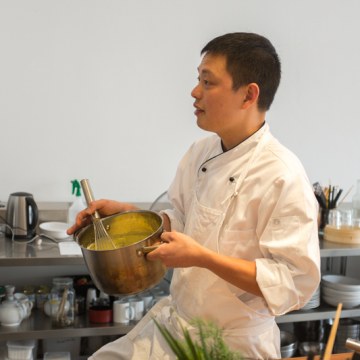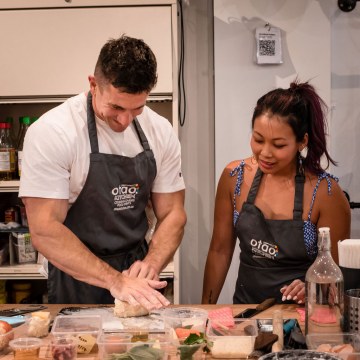It has become an art form, where every detail is meticulously crafted to create a unique and unforgettable experience for guests. From the moment you walk into a private dining space, the ambiance, service, and culinary offerings work together to transport you into a world of luxury, creativity, and personalization.
1. Chef’s Table Experiences
Chef’s table experience has been gaining traction for a while, but in 2024, it’s becoming more immersive and interactive. This trend brings diners closer to the action, allowing them to witness the culinary magic firsthand.
In a typical chef’s table setup, diners sit around a special table in or near the kitchen, where they can watch the chef prepare their meal. This setup not only offers a front-row seat to the cooking process but also facilitates a more personal interaction between the chef and the diners. Guests can ask questions, learn about the techniques being used, and even get tips on how to recreate some of the dishes at home.
This experience is often enhanced with live cooking demonstrations, where the chef explains each dish as it’s being prepared. For instance, you might see a chef expertly fileting a fish or preparing a delicate dessert while discussing the sourcing of the ingredients and the inspiration behind the dish. This not only makes the meal more engaging but also educates diners about the art of cooking.
Interactive culinary experiences often include tasting menus, where each course is paired with a wine or cocktail that complements the flavors. This adds another layer to the dining experience, making it a multi-sensory journey. The chef might even involve diners in some of the cooking, such as rolling sushi or decorating a cake, making it a fun and educational event.
2. Curated Plates and Custom Menus
Gone are the days of set menus and generic dining experiences. Private dining is all about personalization and customization. Curated plates and bespoke menus are tailored to fit the preferences and dietary needs of each guest, creating a truly unique dining experience.
Curated plates are designed to highlight specific ingredients or culinary themes. For example, a chef might create a menu around seasonal produce, showcasing dishes that feature the freshest ingredients available. These menus are often crafted with input from the diners, ensuring that each plate aligns with their tastes and preferences.
Bespoke menus take customization a step further by offering a completely personalized dining experience. Before the event, guests might be asked about their favorite ingredients, dietary restrictions, and preferred cooking styles. Based on this information, the chef designs a menu that caters specifically to their tastes. This could include unique flavor combinations, rare ingredients, or special dietary options like vegan or gluten-free dishes.
This trend is not only about food but also about creating an overall experience that reflects the guest’s preferences. The ambiance, table settings, and even the choice of background music can be tailored to match the theme of the menu. For instance, a Mediterranean-inspired menu might be accompanied by a setting with vibrant colors and traditional music, enhancing the overall dining experience.
3. Wine, Beer, and Cocktail Pairings
Pairing food with the right drink has always been an important aspect of dining, and it’s taking on a new level of sophistication. Wine, beer, and cocktail pairings are becoming an integral part of private dining experiences, with careful consideration given to how each drink complements the food.
Wine pairings are a classic choice, with sommeliers or chefs selecting wines that enhance the flavors of each dish. For instance, a rich, hearty dish might be paired with a full-bodied red wine, while a delicate seafood course could be matched with a crisp white wine. The goal is to create a harmonious balance between the food and the drink, elevating both.
Beer pairings are also gaining popularity, particularly with the rise of craft beers and artisanal brews. Chefs and brewers are experimenting with different styles of beer to find the perfect match for various dishes. For example, a spicy Indian curry might be paired with a hoppy IPA to balance out the heat, while a rich chocolate dessert could be complemented by a smooth stout.
Cocktail pairings add a creative twist to the dining experience. Mixologists might craft cocktails specifically designed to complement each course, using ingredients that mirror the flavors of the dishes. A refreshing cucumber gin and tonic might pair well with a light appetizer, while a rich, spiced bourbon cocktail could enhance the flavors of a hearty main course.
These pairings are often presented as part of a tasting menu, where each course is accompanied by a carefully chosen drink. The pairing process is often explained to the diners, providing insight into the thought process behind each selection and enhancing their appreciation of both the food and the drink.
4. Farm-to-Table Feasts
Sustainability and freshness are key themes in modern dining, and farm-to-table feasts are at the forefront of this trend. Now, more private dining experiences are embracing the farm-to-table philosophy, which emphasizes the use of locally sourced, seasonal ingredients.
Farm-to-table dining starts with sourcing ingredients from local farms and producers, ensuring that the food is as fresh as possible. This approach not only supports local agriculture but also reduces the environmental impact associated with transporting food over long distances.
Private dining events featuring farm-to-table feasts often include a tour of the farm or an introduction to the local producers. This adds an educational component to the dining experience, allowing guests to learn about where their food comes from and the practices involved in growing it.
The menu for a farm-to-table feast is typically designed around the season’s freshest produce. This means that the dishes can vary greatly depending on the time of year, with spring menus featuring asparagus and strawberries, and winter menus highlighting root vegetables and hearty greens. The focus is on showcasing the natural flavors of the ingredients, with minimal processing and a celebration of seasonal bounty.
Farm-to-table dining also aligns with the trend towards more sustainable and ethical eating practices. By choosing ingredients that are locally sourced and produced with care, diners can feel good about their impact on the environment and the communities they support.
5. Themed Dining Events
Themed dining events add an extra layer of excitement and creativity to private dining experiences. Themed dining is becoming more elaborate and immersive, with events designed to transport guests to different times, places, or even fictional worlds.
A themed dining event might revolve around a specific cultural theme, such as a Moroccan night complete with traditional decor, music, and cuisine. Guests might enjoy dishes like tagine and couscous, served in a setting that reflects the rich colors and patterns of Moroccan design.
Alternatively, themed events might focus on a particular historical period, such as a 1920s speakeasy with jazz music and prohibition-era cocktails. The décor, dress code, and menu would all be inspired by the era, creating an authentic and engaging experience for the guests.
Themed dining events also include more playful themes, such as a murder mystery dinner where guests participate in solving a fictional crime while enjoying their meal. These events often include interactive elements and entertainment, making the dining experience not just about food but also about creating lasting memories.
Themed dining allows for a high level of creativity and customization, with each event designed to match the interests and preferences of the host. Whether it’s a formal gala or a casual get-together, themed dining adds an extra dimension to private events, making them more engaging and enjoyable.
6. Pop-up Dinners
Pop-up dinners are an exciting trend that brings a sense of novelty and exclusivity to private dining. These temporary dining events can take place in a variety of unexpected locations, from a rooftop to a secret garden or even a historic building.
The allure of a pop-up dinner lies in its temporary nature and the element of surprise. Guests often don’t know the exact location or menu details until shortly before the event, adding an air of mystery and anticipation. The location is typically chosen to enhance the overall experience, with each pop-up dinner offering a unique atmosphere and setting.
Pop-up dinners are often organized by chefs or culinary teams who want to showcase their creativity and experiment with new ideas. The menus for these events are usually designed to highlight seasonal ingredients or explore new culinary concepts, offering guests a chance to enjoy innovative and exciting dishes.
These events also foster a sense of community and exclusivity. Because pop-up dinners are often limited in size and run for a short time, they create a unique opportunity for guests to connect with others who share a passion for food and adventure.
7. Virtual-Reality and Tech Enhanced Private Dining
Technology is transforming the private dining experience in recent years, with virtual-reality (VR) and other tech enhancements adding a futuristic twist to traditional dining. Virtual reality, in particular, is being used to create immersive and interactive dining experiences that transport guests to different environments.
With VR, diners can experience a meal in a variety of virtual settings, from a serene underwater world to a bustling city street. The technology allows guests to enjoy a meal in a completely different context, enhancing the sensory experience and creating a sense of escapism.
Other tech enhancements include augmented reality (AR) elements, where diners might use AR glasses or devices to see additional visual elements related to their meal. For example, a dish might come with an AR overlay that provides information about its ingredients or the story behind its creation.
Tech-enhanced dining also includes the use of interactive tables and digital menus, which can provide additional information about each dish and offer personalized recommendations based on the diner’s preferences. These technologies make the dining experience more engaging and informative, allowing guests to explore and learn more about their meal.
The integration of technology into private dining is not just about novelty but also about enhancing the overall experience. By combining innovative tech with high-quality food and personalized service, private dining in 2024 is becoming a truly immersive and memorable event.
8. Plant-Based and Sustainable Dining
As more people become conscious of their dietary choices and environmental impact, plant-based and sustainable dining is emerging as a significant trend. Private dining experiences are increasingly featuring menus that emphasize plant-based dishes, locally sourced produce, and sustainable practices.
Plant-based dining isn’t just for vegetarians or vegans anymore; it’s becoming a popular choice for anyone looking to enjoy healthier and more environmentally friendly meals. Chefs are getting creative with vegetables, legumes, and grains, crafting dishes that are as satisfying and flavorful as their meat-based counterparts. From hearty lentil stews to innovative mushroom “steaks,” plant-based menus are proving that you don’t need animal products to create a gourmet experience.
Sustainability goes hand-in-hand with plant-based dining. Many private dining venues are focusing on reducing food waste, using eco-friendly packaging, and sourcing ingredients from sustainable farms. This commitment to sustainability is reflected not just in the food but also in the overall dining experience. For instance, you might find restaurants using energy-efficient appliances, composting food scraps, or even growing their own herbs and vegetables on-site.
This trend appeals to the growing number of diners who prioritize health, wellness, and environmental responsibility. It’s about enjoying delicious food while also making choices that are good for the planet.
Aslo read: 8 Easy Vegan Recipes for all-day Busiers
9. Multi-Sensory Dining Experiences
These days, private dining is becoming an immersive experience that goes beyond just taste. Multi-sensory dining is a trend that engages all the senses—sight, sound, smell, touch, and taste—to create a unique and unforgettable meal.
Imagine walking into a dining room where the lighting changes to match each course, the sound of waves plays softly in the background as you enjoy seafood, and the scent of fresh herbs fills the air as your salad is served. This is the essence of multi-sensory dining: creating an environment where every element enhances the overall experience.
Chefs and event planners are increasingly using technology, art, and design to craft these experiences. For example, projection mapping might be used to create dynamic visuals on the walls or tables, changing in response to the food being served. Aromatic diffusers might release specific scents to complement the flavors of each dish, while carefully curated playlists set the mood for each course.
The goal of multi-sensory dining is to create a fully immersive experience that captivates guests from the moment they arrive. It’s about making dining an event that engages more than just the palate—turning a meal into a journey that delights all the senses.
Book your private dining spaces with Otao Kitchen today!
OTAO Kitchen offers options to suit every budget, style, and occasion. Let us help you create an unforgettable event with a private dining room designed just for you! Whether you're hosting a dinner party, business meeting, or any special occasion, OTAO Kitchen has everything you need.
Make planning any event a breeze with OTAO Kitchen.
Book your private dining room now and start planning your perfect event today!


















































